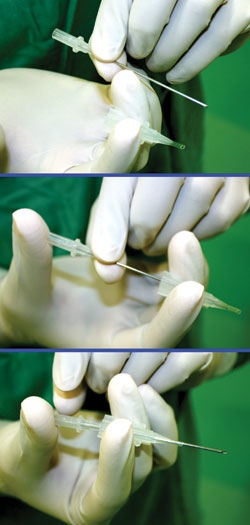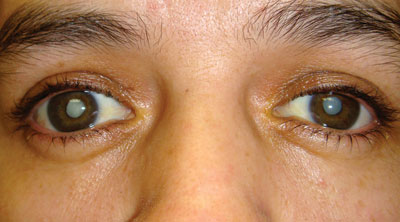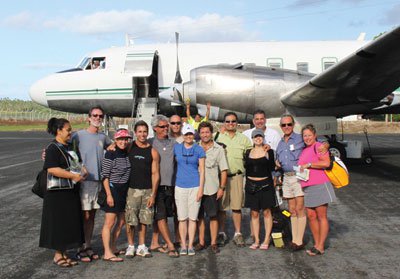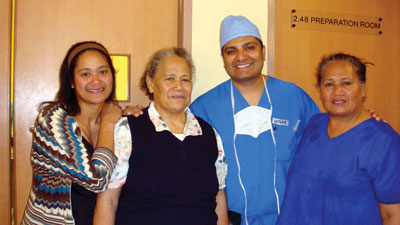Lessons learned from charity surgery mission to Tonga
Cataracts are common in the country, and surgery helps all members of the family, not just the patient.
 Uday Devgan |
The Kingdom of Tonga is a tiny cluster of islands in the Pacific, near Fiji and Samoa, and the first country across the international date line. It is also a country where blindness, principally from cataracts, is so common that the word for blind, “cui,” is the same as the word for grandmother.
The Hawaiian Eye Foundation has been making annual charity surgery mission trips to Tonga for many years, with thousands of surgeries done over the course of decades. When presented with the option of joining the Hawaiian Eye Foundation for a trip to Tonga in September 2009, I jumped on the opportunity. I did not exactly know what to expect, but because it was a group trip with other ophthalmologists and support staff, I knew that we would enjoy working as a team.
Cataracts in Tonga
Tonga is a country focused on a simpler life that is centered on the family. Most houses have multiple generations living under the same roof, with a division of labor that eases the burden on everyone. There is one job, however, that is rarely seen in the U.S.: the “seeing-eye child,” in which one of the young children is designated as the eyes for a blind elder, typically a grandmother, leading her to church and helping her around the home. Giving the gift of sight to the grandmother not only restores her vision, but it also gives a young child newfound freedom to go to school, play with friends and even be a bit mischievous, just like the other kids.
Bilateral dense white cataracts are the rule here, with patients undergoing either phacoemulsification or a manual extracapsular technique. For many of the patients, the technique of small-incision cataract surgery is often the best approach. This involves making a “small” incision of approximately 7-mm width at the sclera, funneling to 10- to 11-mm wide upon entering the anterior chamber. The nucleus is then brought out of the capsular bag and expressed through this incision, which can often be closed without sutures. This procedure is quick and efficient and can be done with fewer supplies and less equipment than phacoemulsification. For patients with dense white cataracts, it also preserves the corneal endothelial cells and makes for a fast recovery of vision. Of course, the large incision induces a significant amount of astigmatism, but compared with the white cataract they had before surgery, patients are very happy and tolerant of just about any residual refraction.
 A homemade IOL injector is fashioned out of an Alcon Monarch cartridge and a blunted 14-gauge IV needle. In eyes that received phacoemulsification, the donated AcrySof IOLs were successfully implanted using this system. Images: Devgan U |
Performing surgery
We had access to an older phaco unit, and coupled with the supplies that we brought from the U.S., including bottles of irrigating fluid, viscoelastics and foldable IOLs, we were able to perform phaco surgeries via clear corneal incisions for some patients. The supplies were donated by many companies, such as Abbott Medical Optics, Alcon Laboratories, Bausch + Lomb and more. Glaukos was kind enough to train me on the use of its iStent glaucoma drainage device and then donate iStents for use in Tonga. Because the iStent is still pending U.S. Food and Drug Administration approval, it gave me a valuable opportunity to learn and use a new technology overseas. As is common on mission trips, we also had to think on our feet and figure out ways to make our supplies last longer (such as using just a drop or two of trypan blue dye for each case so that one syringe would be enough for many surgeries) and to improvise when we did not have a surgical instrument or device (such as using a blunt IV needle as the plunger for inserting Alcon AcrySof IOLs).
 Bilateral white cataracts are a common cause of blindness in Tonga. |
 The Hawaiian Eye Foundation Tonga team from September 2009 is ready to board a 1950s era airplane to travel to the smaller islands. |
 The patient in the black sweater suffered from bilateral white cataracts for many years. After her vision was restored, she celebrated with her family, while the grandson who formerly served as her “seeing-eye child” enjoyed his newfound freedom. |
I truly enjoyed the surgical challenges: dense cataracts, old equipment, lack of modern phaco units, inability to speak the language, and the unfamiliarity of foreign operating room customs and conditions. The intraoperative challenges made me a better surgeon and tested my ability to handle difficult situations. But the true reward came after surgery, when the patients who were blind for years regained their vision. The gratitude expressed by the patients is amazing, with tears of joy from patients as well as their family members. And once the former “seeing-eye children” realized that their elders could see again, they quickly seized the opportunity to run around and play with other kids.
One thing that struck me as odd was the lack of Tongan programs to encourage their citizens to become involved in their own health care. While doing surgery for the Tongans was helpful, I wish that I could have instructed Tongan surgeons, too. I have taught cataract surgery to many ophthalmology residents in the U.S., and I would have enjoyed teaching Tongan surgeons. I would like to see Tonga invest in its youth by setting up programs that sponsor bright Tongan high school children who want to go to college and medical school, and once they have achieved proficiency in a field, bring them back to Tonga to establish health care programs locally. With the right nurturing and guidance, one of those former “seeing-eye children” could be a Tongan cataract surgeon superstar.
After a week of doing surgeries in the capital city of Nuku’alofa, our team spent time flying and sailing to the other islands to see clinic patients, do diabetic retinal laser treatments and perform minor procedures. It was also an opportunity to give school supplies and books to children, enjoy the exotic beauty of the islands, and take a break from my cell phone and e-mail. I came back home to Los Angeles well-rested, with a sense of fulfillment after the mission and with a desire to do more mission trips to other remote corners of the globe.

- Uday Devgan, MD, FACS, can be reached at Devgan Eye Surgery, 11600 Wilshire Blvd., Suite 200, Los Angeles, CA 90025; 800-337-1969; fax 310-388-3028; e-mail: devgan@gmail.com.
- The Hawaiian Eye Foundation is a nonprofit organization dedicated to eye care in the Pacific and Asia regions. Bob Grossman, PhD, is the executive director of the organization and can be reached at 95-717 Kipapa Drive, #23, Mililani, HI 96789; 808-888-6217; e-mail: bob@hawaiianeyefoundation.org.
